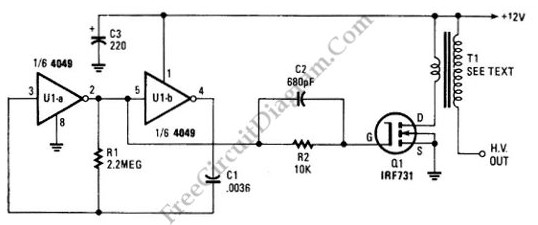
High-Voltage Generator with HEX FET

The schematic diagram below illustrates a high voltage generator circuit. This circuit employs a 4049 hex inverter functioning as an oscillator, with the option to utilize an ignition transformer from an automotive engine. A flyback transformer may also be suitable. The 4049 drives the IRF731 HEX FET, which requires a heatsink for effective thermal management.
The high voltage generator circuit is designed to convert low voltage input into a high voltage output using a combination of oscillation and transformer action. The 4049 hex inverter serves as the core oscillator, producing a square wave output that is essential for driving the transformer. The choice of the ignition transformer or a flyback transformer is critical, as both are capable of stepping up the voltage significantly.
The IRF731 HEX FET is utilized as a switching element in this circuit. It is crucial to ensure that the FET operates within its specified limits, particularly regarding voltage and current ratings. The requirement for a heatsink indicates that the FET will dissipate heat during operation, necessitating adequate thermal management to maintain performance and reliability.
In practical applications, the circuit can be used for generating high voltages for various purposes, including ignition systems, gas tube lighting, or other applications requiring high voltage pulses. Care should be taken to design the circuit layout to minimize parasitic inductance and capacitance, which can affect performance. Additionally, safety precautions must be observed when working with high voltages to prevent electrical hazards.
Overall, this high voltage generator circuit provides a compact and efficient solution for applications requiring high voltage outputs, leveraging the capabilities of the 4049 hex inverter and the selected transformer type.The schematic diagram below show a circuit of high voltage generator. This circuit uses a 4049 hex inverter as an oscillator, and you can use ignition transformer from automotive engine. A fly-back transformer is possibly usable too. The 4049 will drive the IRF731 HEX FET. The Q1 must be heatsinked. Here is the schematic diagram of the circuit: (source: free.. 🔗 External reference
The high voltage generator circuit is designed to convert low voltage input into a high voltage output using a combination of oscillation and transformer action. The 4049 hex inverter serves as the core oscillator, producing a square wave output that is essential for driving the transformer. The choice of the ignition transformer or a flyback transformer is critical, as both are capable of stepping up the voltage significantly.
The IRF731 HEX FET is utilized as a switching element in this circuit. It is crucial to ensure that the FET operates within its specified limits, particularly regarding voltage and current ratings. The requirement for a heatsink indicates that the FET will dissipate heat during operation, necessitating adequate thermal management to maintain performance and reliability.
In practical applications, the circuit can be used for generating high voltages for various purposes, including ignition systems, gas tube lighting, or other applications requiring high voltage pulses. Care should be taken to design the circuit layout to minimize parasitic inductance and capacitance, which can affect performance. Additionally, safety precautions must be observed when working with high voltages to prevent electrical hazards.
Overall, this high voltage generator circuit provides a compact and efficient solution for applications requiring high voltage outputs, leveraging the capabilities of the 4049 hex inverter and the selected transformer type.The schematic diagram below show a circuit of high voltage generator. This circuit uses a 4049 hex inverter as an oscillator, and you can use ignition transformer from automotive engine. A fly-back transformer is possibly usable too. The 4049 will drive the IRF731 HEX FET. The Q1 must be heatsinked. Here is the schematic diagram of the circuit: (source: free.. 🔗 External reference
Warning: include(partials/cookie-banner.php): Failed to open stream: Permission denied in /var/www/html/nextgr/view-circuit.php on line 713
Warning: include(): Failed opening 'partials/cookie-banner.php' for inclusion (include_path='.:/usr/share/php') in /var/www/html/nextgr/view-circuit.php on line 713





